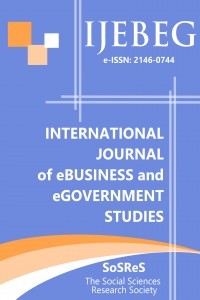INVESTIGATING DIFFERENT USER PROFILES OF E-GOVERNMENT SERVICES FOR TURKEY
INVESTIGATING DIFFERENT USER PROFILES OF E-GOVERNMENT SERVICES FOR TURKEY
e-government, e-government users, expectation and satisfaction of e-government services, user profiling and segmentation,
___
- Affisco, J. F., & Soliman, K. S. (2006). E-government: a strategic operations management framework for service delivery. Business Process Management Journal, 12(1), 13-21.
- Ahn, M. J., & Bretschneider, S. (2011). Politics of E‐Government:
- E‐Government and the Political Control of Bureaucracy. Public Administration Review, 71(3), 414-424. Bertot, J. C., & Jaeger, P. T. (2006). User-centered e-government: Challenges and benefits for government Web sites. Quarterly,23(2),163-168.
- Government Information Ciborra, C. (2005). Interpreting e-government and development: Efficiency, transparency or governance at a distance?. Information Technology & People,18(3), 260-279.
- Dwivedi, Y. K., & Williams, M. D. (2008). Demographic influence on UK citizens'e-government adoption. Electronic Government, an International Journal, 5(3),261-274.
- Kim, T. H., Im, K. H., & Park, S. C. (2005). Intelligent measuring and improving model for customer satisfaction level in e-government. In Electronic
- Government(pp. 38-48). Springer Berlin Heidelberg. Margetts,H.,& Dunleavy,P.(2002). Cultural barriers to e-government.Academic article in support of better public services through e-government. National
- Audit Office, Ordered by the House of Commons, London. Minhas, R. S., & Jacobs, E. M. (1996). Benefit segmentation by factor analysis: an improved method of targeting customers for financial services.
- International Journal of Bank Marketing, 14(3), 3-13. Moon, M. J. (2002). The Evolution of E‐Government among Municipalities:
- Rhetoric or Reality?. Public administration review, 62(4), 424-433. Pan, S. L., Tan, C.W., & Lim, E.T. (2006). Customer relationship management
- (CRM) in e-government: a relational perspective. Systems, 42(1), 237-250. Decision Support Punj, G., & Stewart, D.W.(1983). Cluster analysis in marketing research: review and suggestions for application.Journal of marketing research,134-148.
- Rice, R. E., & Katz, J. E. (2003). Comparing internet and mobile phone usage: digital divides of usage, adoption, and dropouts. Policy,27(8), 597-623. Telecommunications
- Rogers, E.M. (1995). Diffusion of Innovation. Free Press, New York.
- Smith, W. R. (1956). Product differentiation and market segmentation as alternative marketing strategies. The Journal of Marketing, 21(1), 3-8.
- Venkatesh, V., Chan, F. K., & Thong, J. Y. (2012). Designing e-government services: Key service attributes and citizens’ preference structures. Journal of
- Operations Management, 30(1), 116-133.
- Başlangıç: 2009
- Yayıncı: Sosyal Bilimler Araştırmaları Derneği
A KNOWLEDGE MANAGEMENT APPROACH TO CITIZEN RELATIONSHIP MANAGEMENT IN E-GOVERNMENT CONTEXT
Norshidah MOHAMED, Nor Shahriza Abdul KARİM, Mohamed Jalaldeen Mohamed RAZİ
MANAGEMENT OF TASKS IN VIRTUALIZED ENVIRONMENTS
COBIT-5 FRAMEWORK as a MODEL FOR THE REGIONAL DEVELOPMENT AGENCIES IN TURKEY
INVESTIGATING DIFFERENT USER PROFILES OF E-GOVERNMENT SERVICES FOR TURKEY
Abdulkadir HIZIROĞLU, Hala ALKHATİP, Emel AKTAŞ, Tunç D. MEDENİ, Habin LEE, Özkan DALBAY
Tijen ÖVER ÖZÇELİK, Mesut ŞAHİN
“SOCIAL KNOWLEDGE CO-CONSTRUCTION” CONCEPTUAL FRAMEWORK AND GOOGLE+ APPLICATIONS
Cemil UZUN, Figen DEMİREL UZUN, Tunç MEDENİ
TOWORDS AN ALGERIAN E-GOVERNMENT STRATEGY AND ACHIEVEMENTS
Djilali IDOUGHI, Djeddi ABDELHAKIM
A.selçuk KÖYLÜOĞLU, Haydar İNCE, Özdal KOYUNCUOĞLU, Muammer ZERENLER
SCHOOLING AND SCHOOL LEADERSHIP IN KAZAKHSTAN: SUGGESTIONS FOR INNOVATIVE PRACTICE
